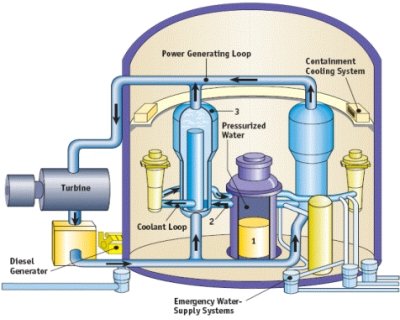North Anna Nuclear Generating Station, Virginia
Next Update: October 2009
North Anna Nuclear Generating Station
Net Generation and Capacity, 2007
Unit |
Net Capacity MW(e) |
Generation (Million Kilowatt Hours) |
Capacity Factor (Percent) |
Type | On Line Date |
License Expiration Date* |
| 1 | 924 | 7,215.138 | 89.1 | PWR | June 6,1978 | April 1, 2038 |
| 2 | 910 | 6,771.789 | 84.9 | PWR | Dec. 14, 1980 | August 21, 2040 |
| 1,834 | 13,986.927 | 87.1 | ||||
| *On March 30, 2003, the Nuclear Regulatory Commission approved license renewal applications and extended the termination data by 20 years. The original license for unit 1 would have expired in 2018 and for unit 2, in 2020. PWR = pressurized light water reactors. Sources |
||||||
Description: The North Anna nuclear power station is on a 1,075-acre site in Louisa County, Virginia. In November 2007, Dominion filed a combined license application with the U.S. Nuclear Regulatory Commission (NRC) to build a third reactor at North Anna. More information on this application is available in the Status of Potential New Commercial Reactors in the United States.
North Anna, Unit 1
Nuclear Steam System Supplier (NSSS Vendor) = Westinghouse Electric
Architect Engineer = Stone & Webster
Owner = The North Anna Plant is owned by the Dominion Virginia Power corporation (88.4 percent) and by the Old Dominion Electric Cooperative (11.6 percent).
Operator (Licensee) = North Anna is operated by Dominion Generation company
North Anna, Unit 2
Nuclear Steam System Supplier (NSSS Vendor) = Westinghouse Electric
Architect Engineer = Stone & Webster
Owner = The North Anna Plant is owned by the Dominion Virginia Power corporation (88.4 percent) and by the Old Dominion Electric Cooperative (11.6 percent).
Operator (Licensee) = North Anna is operated by Dominion Generation company.
Pressurized-Water Reactor (PWR)
In a typical commercial pressurized light-water reactor (1) the reactor core generates heat, (2) pressurized-water in the primary coolant loop carries the heat to the steam generator, (3) inside the steam generator heat from the primary coolant loop vaporizes the water in a secondary loop producing steam, (4) the steam line directs the steam to the main turbine causing it to turn the turbine generator, which produces electricity. The unused steam is exhausted to the condenser where it is condensed into water. The resulting water is pumped out of the condenser with a series of pumps, reheated, and pumped back to the steam generator. The reactors core contains fuel assemblies which are cooled by water, which is force-circulated by electrically powered pumps. Emergency cooling water is supplied by other pumps, which can be powered by onsite diesel generators. Other safety systems, such as the containment cooling system, also need power.
 |
| © U.S. Nuclear Regulatory Commission |
Containment: According to the U.S. Nuclear Regulatory Commission, both PWR units have dry, subatmospheric1 containment.
_________________________________________
1Dry, Subatmospheric: a reactor containment design which is held a negative (sub-atmospheric) pressure (i.e., a vacuum) during normal operations. When a pipe breaks or a steam release occurs in this design, much of the initial internal pressure rise is countered by the negative pressure that is already present. As a result, the final pressure reached is lower than that which would have occurred if the containment had started out at zero psig (atmospheric pressure). NOTE: If the expected containment pressure buildup from steam in an accident is say, +10 psig; and the containment walls will burst at 8 psig; - you can eliminate the possibly of a containment failure by simply starting out at negative 5 psig instead of 0 psig. So when the accident occurs, the pressure will rise from -5 psig to just +5 psig and still be safe.
Sources for Data in Table: Capacity, for purposes of this report, is the net summer capability as reported in Energy Information Administration (EIA) Form EIA-860, "Annual Electric Generator Report." Capacity Factor is a percentage calculation in which the maximum possible generation (based on net summer capability) is divided into the actual generation then multiplied by 100. Generation is the net electricity output reported by plant owners on Form EIA-906, “Power Plant Report.” Type of Unit: All U.S. commercial reactors currently in operation are one of two types: BWR (boiling water reactor) or PWR (pressurized light water reactor). The type, on-line date, and the license expiration date are published annually in Information Digest by the U.S. Nuclear Regulatory Commission.